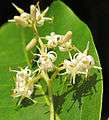Apodytes
| Apodytes | |
|---|---|
 | |
| Apodytes dimidiata | |
| Scientific classification | |
| Kingdom: | Plantae |
| Clade: | Angiosperms |
| Clade: | Eudicots |
| Clade: | Asterids |
| Order: | Metteniusales |
| Family: | Metteniusaceae |
| Genus: | Apodytes E.Mey. ex Arn. (1840) |
| Species | |
|
See text. | |
Apodytes is a genus of flowering plants in the family Metteniusaceae. It was formerly either unplaced as to family or placed in the family Icacinaceae.[1] It consists of about 8 species of evergreen trees, from tropical northeastern Australia, New Caledonia, Africa and Asia. The exact number of species has been revised from 3 to 8, according to The Plant List.[2]
Description
All of the species have simple, smooth-edged, leathery leaves and much-branched panicles of small white flowers with recurving petals and conspicuous stamens. The fruits are small drupes with a fleshly appendage on one side attached to the fruit, termed a pseudoaril.
The African species (Apodytes dimidiata) is grown for its attractive display of white blossom and red and black fruit, as well as for shade, screening and hedges. It is also grown in southern Africa for ornament and timber, and a bark preparation is used to drive out intestinal parasites.
Taxonomy
It was previously placed in a broadly circumscribed Icacinaceae, but since that family was split it is unplaced as both family and order rank. Recent research suggest that it is associated with Garryales, though possibly not closely enough to warrant broadening that order to include it.[3][4]
Cultivation
It adapts readily to gardens in warm-temperate to tropical climates, though growth is not particularly fast and it can be kept to large shrub size. A deep fertile soil suits it best but it will grow in poorer soils. Propagate from fresh seed.
Species
The original classification included only 3 species, but recently the genus was revised to include 8 species.[2]
- Apodytes abbottii Potg. & A.E.van Wyk
- Apodytes bebile Labat, R.Rabev. & El-Achkar
- Apodytes brachystylis F.Muell.
- Apodytes clusiifolia (Baill.) Villiers
- Apodytes dimidiata E.Mey. ex Arn.
- Apodytes geldenhuysii A.E.van Wyk & Potgieter
- Apodytes grandifolia (Miers) Benth. & Hook.f. ex B.D.Jacks.
- Apodytes thouvenotii Danguy
References
| Wikimedia Commons has media related to Apodytes. |
- ↑ Angiosperm Phylogeny Group (2016). "An update of the Angiosperm Phylogeny Group classification for the orders and families of flowering plants: APG IV". Botanical Journal of the Linnean Society. 181 (1): 1–20. doi:10.1111/boj.12385.
- 1 2 The Plant List
- ↑ http://www.mobot.org/mobot/research/apweb/orders/garryalesweb.htm
- ↑ http://www.amjbot.org/content/88/12/2259.full
- Botanica Sistematica
- Lord, Tony (2003) Flora : The Gardener's Bible : More than 20,000 garden plants from around the world. London: Cassell. ISBN 0-304-36435-5
